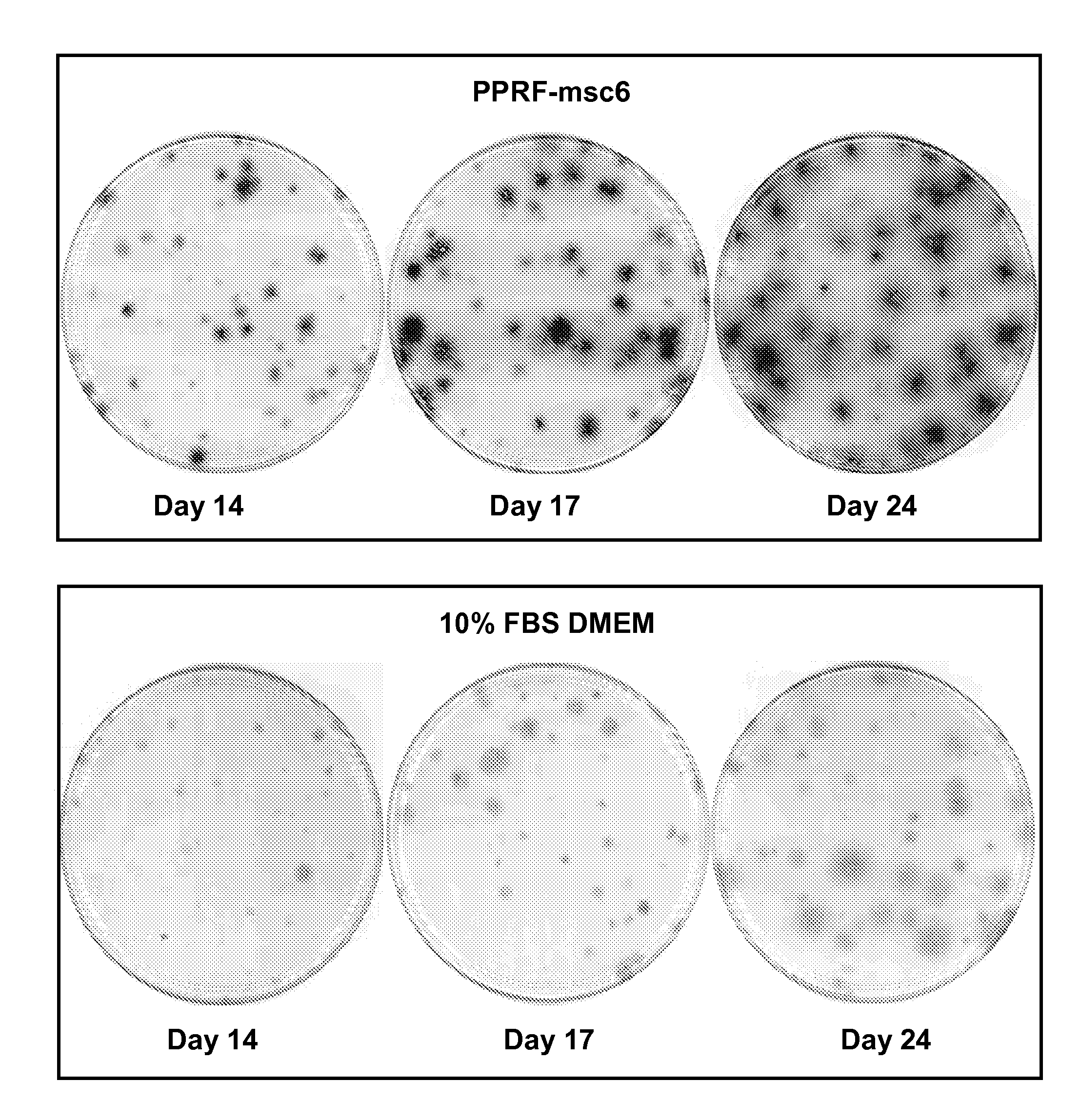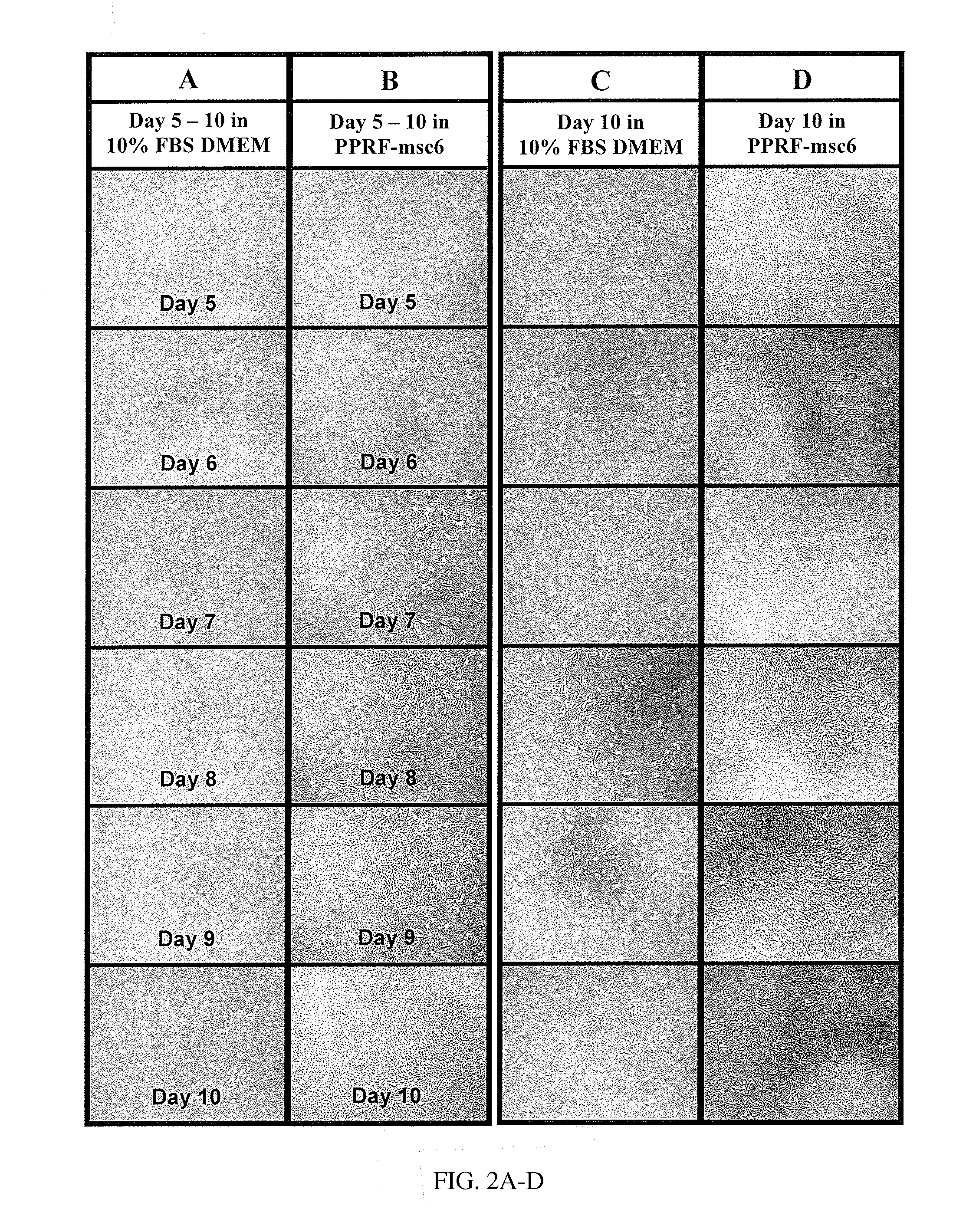Methods and Compositions for Isolating, Maintaining and Serially Expanding Human Mesenchymal Stem Cells
a mesenchymal stem cell and serial expansion technology, applied in the field of cell biology and stem cell bioengineering, can solve the problems of eliciting immune reactions, difficult to interpret experiments carried out in fbs-containing media, and difficult to standardize a cell production process
- Summary
- Abstract
- Description
- Claims
- Application Information
AI Technical Summary
Benefits of technology
Problems solved by technology
Method used
Image
Examples
example 1
Isolation and Serial Expansion of hMSCs from Bone Marrow Using PPRF-msc6 Medium
[0099]For this example, as well as Example 2, the constituent of PPRF-msc6 medium was used for all primary and subsequent cultures described herein and is shown in Table 2. The isolation and subsequent serial expansion of hMSCs were performed in a humidified incubator at 37° C. and 5% CO2 for all cultures described herein. The cultured cells were characterized as hMSCs by performing various assays such as CFU-F assay, flow cytometry analysis, and differentiation assays.
TABLE 2Components of PPRF-msc6 medium for humanmesenchymal stem cell (hMSC) cultureComponentSupplier & Cat #Final ConcentrationDMEMGibco 121000.5xF12Gibco 217000.5xGlutamineGibco 250301.5mMSodium bicarbonateSigma S57611.725g / LHepesSigma H40344.9 mM (1.167 g / L)Serum albuminInVitro Care 21014g / LLipid concentrateGibco 119051xInsulinSigma I550023mg / Lapo-TransferrinSigma T225225mg / LPutrescineSigma P75059.0mg / LProgesteroneSigma P61495.66μg / LFetui...
example 2
Isolation and Serial Expansion of hMSCs from Adipose Tissue Using PPRF-msc6 Medium
[0105]The isolation of hMSCs from adipose tissue (AT-hMSCs) and their serial expansion were compared using PPRF-msc6 and FBS-supplemented medium from Lonza (10% FBS DMEM). As described in the methods invented herein, a population of cells derived from human abdominal subcutaneous adipose tissue was plated at a density of 2,000 cells / cm2 into protein-coated tissue culture flasks containing growth medium. After 48 hours, non-adherent cells were removed and fresh medium was added. Thereafter, 50% of the medium was replenished every other day. When well-developed colonies appeared in the cultures, the adherent cells were harvested by trypsinization, counted, and replated into new flasks at a density of 5,000 cells / cm2. The serial passaging of cells were performed using the same passage protocols. FIG. 11, which presents the growth kinetics of primary and subsequent cultures of AT-hMSCs in both PPRF-msc6 an...
example 3
Isolation and Serial Expansion of hMSCs from Adipose Tissue Using PPRF-msc6 Medium
[0108]The inventors have defined factors required for the isolation and subsequent expansion of tissue-specific hMSCs under new serum-free conditions. PPRF-msc6 represents the most well-defined serum-free formulation described in the literature to date, for (i) the successful isolation of hMSCs from primary cultures of bone marrow and other sources such as adipose tissue and (ii) the subsequent expansion of these isolated MSCs through multiple passages while maintaining high proliferation rates. Although all the ingredients are defined in terms of origin and purity, PPRF-msc6 is not considered to be a xeno-free medium as the insulin and fetuin used in this medium are purified from animal serum. It is well known that these purified components can be associated with traces of other serum constituents, which may affect cell growth. Nonetheless, the development of PPRF-msc6 represents a significant step fo...
PUM
| Property | Measurement | Unit |
|---|---|---|
| total volume | aaaaa | aaaaa |
| concentration | aaaaa | aaaaa |
| concentrations | aaaaa | aaaaa |
Abstract
Description
Claims
Application Information
 Login to View More
Login to View More - R&D
- Intellectual Property
- Life Sciences
- Materials
- Tech Scout
- Unparalleled Data Quality
- Higher Quality Content
- 60% Fewer Hallucinations
Browse by: Latest US Patents, China's latest patents, Technical Efficacy Thesaurus, Application Domain, Technology Topic, Popular Technical Reports.
© 2025 PatSnap. All rights reserved.Legal|Privacy policy|Modern Slavery Act Transparency Statement|Sitemap|About US| Contact US: help@patsnap.com



